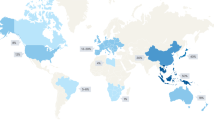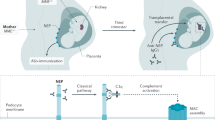Abstract
IgA glomerulonephritis accounts for 25–50% of renal biopsy diagnoses. About 25–50% of patients progress to end-stage renal disease within 20 years of diagnosis. Angiotensin-converting enzyme inhibitors and angiotensin II type I receptor blockers slow progression of IgA nephropathy (IgAN); however, as drugs of this class are not IgAN specific and are therefore unlikely to alter significantly its natural course, many other therapeutic approaches have been proposed. Most have been tested in a relatively small number of patients and have not yet proven to be effective in the long term. Conflicting and variable data, and a lack of long-term prospective randomized studies, mean that most treatments cannot be recommended as standard therapy for IgAN. Steroids seem to be the best treatment for patients with proteinuria, as drugs in this class ameliorate this symptom and protect against deterioration of renal function. Combined treatment with corticosteroids and cytotoxic drugs has yielded interesting results in several studies, especially in progressive patients with severe IgAN. In this review, we critically analyze the data on these treatments.
Key Points
-
Incomplete understanding of the pathogenesis of IgA nephropathy has hampered development of targeted therapies
-
Angiotensin-converting enzyme inhibitors and angiotensin II type I receptor blockers slow progression of IgA nephropathy to end-stage renal disease
-
Low-antigen diets, sodium cromoglicate, phenytoin, danazol and high-dose immunoglobulins have been superseded by more effective interventions
-
Tonsillectomy, fish oil, corticosteroids and cytotoxic drugs are currently the most promising treatments
-
No treatment can be unequivocally recommended until large randomized, controlled trials are performed
This is a preview of subscription content, access via your institution
Access options
Subscribe to this journal
Receive 12 print issues and online access
$209.00 per year
only $17.42 per issue
Buy this article
- Purchase on Springer Link
- Instant access to full article PDF
Prices may be subject to local taxes which are calculated during checkout
Similar content being viewed by others
References
Koyama A et al. (1997) Natural history and risk factors for immunoglobulin A nephropathy in Japan. Am J Kidney Dis 4: 526–532
Stratta P et al. (1996) Incidence of biopsy-proven primary glomerulonephritis in an Italian province. Am J Kidney Dis 27: 631–639
D'Amico G et al. (1985) Idiopathic IgA mesangial nephropathy. Clinical and histological study of 374 patients. Medicine 64: 49–60
Alamartine E et al. (1991) Prognostic factors in mesangial IgA glomerulonephritis: an extensive study with univariate and multivariate analysis. Am J Kidney Dis 1: 12–19
Ibels LS et al. (1994) IgA nephropathy: Analysis of the natural history, important factors in the progression of renal disease and a review of the literature. Medicine 73: 79–102
Usui J et al. (2001) Heterogeneity of prognosis in adult IgA nephropathy, especially with mild proteinuria or mild histological features. Intern Med 40: 697–702
Szeto CC et al. (2001) The natural history of immunoglobulin A nephropathy among patients with hematuria and minimal proteinuria. Am J Med 110: 434–437
Xu LX and Zhao MH (2005) Aberrantly glycosylated serum IgA1 are closely associated with pathologic phenotypes of IgA nephropathy. Kidney Int 68:167–172
Kokubo T et al. (2000) Humoral immunity against the proline-rich peptide epitope of the IgA1 hinge region in IgA nephropathy. Nephrol Dial Transplant 15: 28–33
Amore A et al. (2001) Glycosylation of circulating IgA in patients with IgA nephropathy modulates proliferation and apoptosis of mesangial cells. J Am Soc Nephrol 12: 862–871
Coppo R et al. (2004) Aberrant glycosilation in IgA nephropathy (IgAN). Kidney Int 65: 1544–1547
Emancipator SN (1990) Immunoregulatory factors in the pathogenesis of IgA nephropathy. Kidney Int 38: 1216–1229
Chow KM et al. (2005) Genetics of common progressive renal disease. Kidney Int Suppl 94: S41–S45
Ruggenenti P et al. (2000) Chronic proteinuric nephropathies: outcomes and response to treatment in a prospective cohort of 352 patients with different patterns of renal injury. Am J Kidney Dis 35: 1155–1165
Praga et al. (2003) Treatment of IgA nephropathy with ACE inhibitors: a randomized and controlled trial. J Am Soc Nephrol 14: 1578–1583
Nakao N et al. (2003) Combination treatment of angiotensin-II receptor blocker and angiotensin-converting-enzyme inhibitor in non-diabetic renal disease (COOPERATE): a randomised controlled trial. Lancet 361: 117–124
Coppo R et al. (1990) Effects of a gluten-free diet in primary IgA nephropathy. Clin Nephrol 33: 72–86
Bazzi C et al. (1992) Low doses of drugs able to alter intestinal mucosal permeability to food antigens (5-aminosalicylic acid and sodium cromoglycate) do not reduce proteinuria in patients with IgA nephropathy. A preliminary non controlled trial. Nephron 61: 192–195
Clarckson AR et al. (1980) Controlled trial of phenytoin therapy in IgA nephropathy. Clin Nephrol 13: 215–218
Tomino Y et al. (1984) Effect of danazol on solubilization of immune deposits in patients with IgA nephropathy. Am J Kidney Dis 4: 135–140
Rostoker G et al. (1995) Immunomodulation with low-dose immunoglobulins for moderate IgA nephropathy and Henoch-Schöenlein purpura: preliminary results of a prospective uncontrolled trial. Nephron 69: 327–334
Tomioka S et al. (1996) Clinical study of chronic tonsillitis with IgA nephropathy treated by tonsillectomy. Acta Otolaryngol (Stockh) 523 (Suppl): S175–S177
Hotta O et al. (1996) Long-term effects of intensive therapy combined with tonsillectomy in patients with IgA nephropathy. Acta Otolaryngol (Stockh) 523 (Suppl): S165–S168
Hotta O et al. (2001) Tonsillectomy and steroid pulse therapy significantly impact on clinical remission in patients with IgA nephropathy. Am J Kidney Dis 38: 736–743
Xie Y et al. (2003) The efficacy of tonsillectomy on long-term renal survival in patients with IgA nephropathy. Kidney Int 63: 1861–1867
Akagi H et al. (2004) Long-term results of tonsillectomy as a treatment for IgA nephropathy. Acta Otolaryngol 555 (Suppl): S38–S42
Matutani S et al. (2004) Clinical observation of palatine tonsils in IgA nephropathy. Acta Otolaryngol 555 (Suppl): S58–S61
Windfuhr JP et al. (2003) Post-tonsillectomy and -adenoidectomy hemorrhage in nonselected patients. Ann Otol Rhinol Laryngol 112: 63–70
Hamazaki T et al. (1984) Eicosapentaenoic acid and IgA nephropathy. Lancet 1: 1017–1018
Cheng I et al. (1990) The effect of fish-oil dietary supplement on the progression of mesangial IgA glomerulonephritis. Nephrol Dial Transplant 5: 241–246
Bennett W et al. (1989) Treatment of IgA nephropathy with eicosapentanoic acid (EPA): a two-year prospective trial. Clin Nephrol 31: 128–131
Petterson E et al. (1994) Treatment of IgA nephropathy with omega-3 polyunsaturated fatty acids: a prospective, double-blind, randomized study. Clin Nephrol 41: 183–190
Donadio JV Jr et al. (1994) A controlled trial of fish oil in IgA nephropathy. N Engl J Med 331: 1194–1199
Donadio JV Jr et al. (1999) The long-term outcome of patients with IgA nephropathy treated with fish oil in a controlled trial. Mayo Nephrology Collaborative Group. J Am Soc Nephrol 10: 1772–1777
Donadio JV Jr et al. (2001) A randomized trial of high-dose compared with low-dose omega-3 fatty acids in severe IgA nephropathy. J Am Soc Nephrol 12: 791–799
Dillon JJ (1997) Fish oil therapy for IgA nephropathy: efficacy and interstudy variability. J Am Soc Nephrol 8: 1739–1744
Kobayashi Y et al. (1988) Steroid therapy in IgA nephropathy: a retrospective study in heavy proteinuric cases. Nephron 48: 12–17
Waldo FB et al. (1993) Treatment of IgA nephropathy in children: efficacy of alternate-day oral prednisone. Pediatr Nephrol 7: 529–532
Kobayashi Y et al. (1996) Steroid therapy during the early stage of progressive IgA nephropathy. A 10-year follow-up study. Nephron 72: 237–242
Lai KN et al. (1986) Corticosteroid therapy in IgA nephropathy with nephrotic syndrome: a long-term controlled trial. Clin Nephrol 26: 174–180
Welch TR et al. (1992) Double-blind, controlled trial of short-term prednisone therapy in immunoglobulin A glomerulonephritis. J Pediatr 121: 474–477
Julian B et al. (1993) Alternate-day prednisone therapy in IgA nephropathy: preliminary analysis of a prospective randomized controlled trial. Contrib Nephrol 104: 198–206
Nicholls K et al. (1994) Prednisolone decreases hematuria in IgA nephropathy [abstract #929]. Kidney Int 46
Shoji T et al. (2000) Early treatment with corticosteroids ameliorates proteinuria, proliferative lesions, and mesangial phenotypic modulation in adult diffuse proliferative IgA nephropathy. Am J Kidney Dis 35: 194–201
Katafuchi R et al. (2003) Prospective trial of steroid treatment in IgA nephropathy: a limitation of low-dose prednisolone therapy. Am J Kidney Dis 41: 972–983
Pozzi C et al. (1999) Corticosteroids in IgA nephropathy: a randomised controlled trial. Lancet 353: 883–887
Pozzi C et al. (2004) Corticosteroid effectiveness in IgA nephropathy: long-term results of a randomized, controlled trial. J Am Soc Nephrol 15: 157–163
Lay KN et al. (1987) Cyclosporin treatment of IgA nephropathy: a short term controlled trial. Br Med J 295: 1165–1168
Maes BD et al. (2004) Mycophenolate mofetil in IgA nephropathy: results of a 3-year prospective placebo-controlled randomized study. Kidney Int 65: 1842–1849
Frisch G et al. (2005) Mycophenolate mofetil (MMF) vs placebo in patients with moderately advanced IgA nephropathy: a double-blind randomized controlled trial. Nephrol Dial Transplant 20: 2139–2145
Tang S et al. (2005) Mycophenolate mofetil alleviates persistent proteinuria in IgA nephropathy. Kidney Int 68: 802–812
Chandrakantan A et al. (2005) Recurrent IgA nephropathy after renal transplantation despite immunosuppressive regimens with mycophenolate mofetil. Nephrol Dial Transplant 20: 1214–1221
Woo KT et al. (1987) Effects of triple therapy on the progression of mesangial proliferative glomerulonephritis. Clin Nephrol 27: 56–64
Walker RG et al. (1990) The treatment of mesangial IgA nephropathy with cyclophosphamide, dipyridamole and warfarin: a two-year prospective trial. Clin Nephrol 34: 103–107
Yoshikawa N et al. (1999) Combined therapy with prednisolone, azathioprine, heparin–warfarin, and dipyridamole for paediatric patients with severe IgA nephropathy—is it relevant for adult patients? Nephrol Dial Transplant 14: 1097–1099
Roccatello D et al. (2000) Steroid and cyclophosphamide in IgA nephropathy. Nephrol Dial Transplant 15: 833–835
Tsuruya K et al. (2000) Combination therapy using prednisolone and cyclophosphamide slows the progression of moderately advanced IgA nephropathy. Clin Nephrol 53: 1–9
Ballardie FW et al. (2002) Controlled prospective trial of prednisolone and cytotoxics in progressive IgA nephropathy. J Am Soc Nephrol 13: 142–148
Goumenos DS et al. (2003) Prednisolone and azathioprine in IgA nephropathy—a ten-year follow-up study. Nephron Clin Pract 93: C47–C48
Tumlin JA et al. (2003) Crescentic, proliferative IgA nephropathy: clinical and histological response to methylprednisolone and intravenous cyclophosphamide. Nephrol Dial Transplant 18: 1321–1329
Locatelli F et al. (1999) Combined treatment with steroids and azathioprine in IgA nephropathy: design of a prospective randomised multicentre trial. J Nephrol 12: 308–311
Bianchi S et al. (2003) A controlled, prospective study of the effects of atorvastatin on proteinuria and progression of kidney disease. Am J Kidney Dis 41: 565–570
Author information
Authors and Affiliations
Corresponding author
Ethics declarations
Competing interests
The authors declare no competing financial interests.
Related links
Rights and permissions
About this article
Cite this article
Locatelli, F., Vecchio, L. & Pozzi, C. IgA glomerulonephritis: beyond angiotensin-converting enzyme inhibitors. Nat Rev Nephrol 2, 24–31 (2006). https://doi.org/10.1038/ncpneph0055
Received:
Accepted:
Issue Date:
DOI: https://doi.org/10.1038/ncpneph0055
This article is cited by
-
Pathological sub-analysis of a multicenter randomized controlled trial of tonsillectomy combined with steroid pulse therapy versus steroid pulse monotherapy in patients with immunoglobulin A nephropathy
Clinical and Experimental Nephrology (2016)
-
Comparison of inhibitors of renin–angiotensin–aldosterone system (RAS) and combination therapy of steroids plus RAS inhibitors for patients with advanced immunoglobulin A nephropathy and impaired renal function
Clinical and Experimental Nephrology (2012)
-
Long-term beneficial effects of angiotensin-converting enzyme inhibitor and angiotensin receptor blocker therapy for patients with advanced immunoglobulin A nephropathy and impaired renal function
Clinical and Experimental Nephrology (2011)
-
Histologically advanced IgA nephropathy treated successfully with prednisolone and cyclophosphamide
Clinical and Experimental Nephrology (2007)



